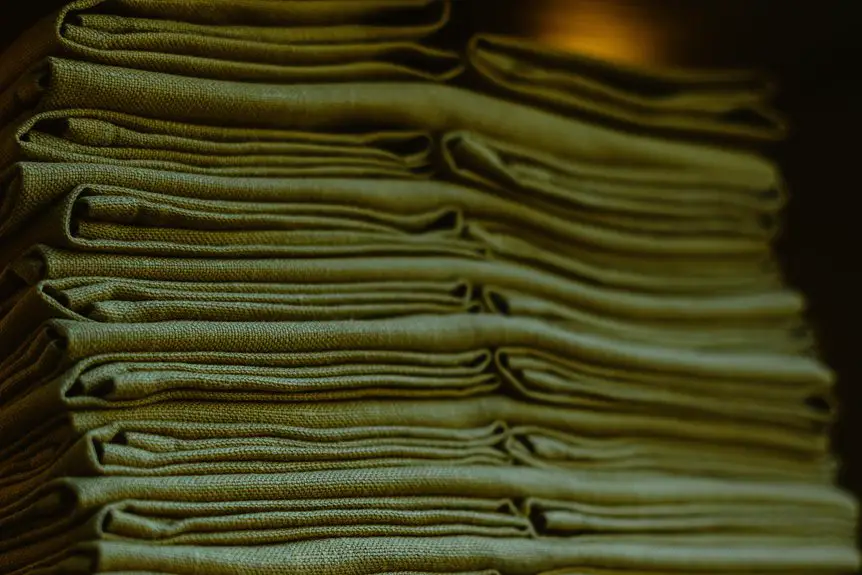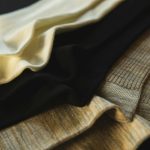If you want durability with comfort, the 60/40 cotton/poly blend offers softness and wrinkle resistance, ideal for everyday wear. The 50/25/25 tri-blend adds a silky feel and lightweight drape, blending cotton, polyester, and rayon for softness and style. For premium softness and breathability, 100% ringspun cotton is great, though less durable. Each fabric suits different needs, and understanding their pros helps you pick the perfect fit for your project’s comfort and longevity.
Table of Contents
Key Takeaways
- 60/40 cotton/poly blend combines softness with durability, offering wrinkle resistance and faster drying than pure cotton.
- 50/25/25 tri-blend includes rayon for a silky texture, lightweight feel, and enhanced drape alongside cotton and polyester.
- 100% ringspun cotton provides superior softness, breathability, and moisture absorption but is less durable than blends.
- Blends with polyester resist shrinking, tearing, and pilling better than 100% ringspun cotton fabrics.
- Ideal uses vary: 60/40 for everyday durability, tri-blend for soft casual wear, and ringspun cotton for premium comfort.
Understanding Cotton and Polyester Fibers
Although cotton and polyester are often blended together, each fiber has unique qualities that affect how the fabric feels, performs, and lasts.
Cotton and polyester each bring distinct qualities that influence fabric comfort, durability, and care.
When you wear cotton, you’ll notice its softness and breathability, making it comfortable and ideal for warm weather. Cotton fibers absorb moisture, which helps keep you cool but can also make the fabric take longer to dry.
Polyester, on the other hand, feels smooth and slightly slick. It’s durable, resists wrinkles, and dries quickly, which is perfect if you want low-maintenance clothing.
However, polyester isn’t as breathable as cotton and may feel less natural against your skin. Understanding these differences helps you choose fabrics that suit your needs, whether you prioritize comfort, durability, or ease of care.
What Does 60/40 Cotton/Poly Mean?
When you see 60/40 cotton/poly, it means the fabric is made of 60% cotton and 40% polyester.
This blend combines the softness of cotton with the durability and wrinkle resistance of polyester.
You’ll often find it used in everyday clothing because it balances comfort and long-lasting wear.
Fabric Composition Breakdown
Understanding fabric composition is key to choosing the right material for your needs. When you see 60/40 cotton/poly, it means the fabric is made of 60% cotton and 40% polyester. This blend balances natural softness with synthetic durability.
Here’s a quick breakdown:
| Component | Percentage | Key Feature |
|---|---|---|
| Cotton | 60% | Breathability |
| Polyester | 40% | Wrinkle resistance |
| Total Blend | 100% | Balanced comfort |
Knowing this helps you understand how the fabric will behave—cotton offers comfort and breathability, while polyester adds strength and reduces shrinkage. This combination is popular for apparel that needs to feel good and last longer.
Benefits of Cotton/Poly
Knowing the composition of a 60/40 cotton/poly blend helps you appreciate why this mix is so popular.
You get the natural softness and breathability of cotton combined with the strength and wrinkle resistance of polyester. This means your fabric feels comfortable against your skin but also holds up better over time. You won’t have to worry about shrinking as much compared to 100% cotton.
Plus, it dries faster, making it a practical choice for everyday wear. The polyester content helps maintain shape and color, so your clothes look fresh longer.
Common Uses and Durability
Because a 60/40 cotton/poly blend combines natural and synthetic fibers, it offers a versatile fabric that suits many everyday uses. You’ll find it in casual tees, workwear, and sports apparel because it balances comfort with durability. It resists shrinking and wrinkles better than pure cotton, making it easier to care for. When you wear garments made from this blend, you get softness plus long-lasting strength.
Here’s a quick look at how this fabric fits your lifestyle:
| Use Case | Why It Works for You |
|---|---|
| Casual Wear | Soft comfort all day |
| Work Uniforms | Durable, holds shape well |
| Sports Apparel | Breathable and moisture-wicking |
| Everyday Washing | Shrink-resistant, easy care |
Benefits of a 60/40 Cotton/Poly Blend
When you choose a 60/40 cotton/poly blend, you get the best of both worlds—comfort and durability. The cotton provides softness and breathability, making the fabric comfortable to wear all day.
Meanwhile, the polyester adds strength and wrinkle resistance, so your clothes maintain their shape and look sharp longer. You’ll also notice this blend dries faster than pure cotton, which is perfect if you’re active or need low-maintenance apparel.
Plus, it resists shrinking and fading better, so your favorite pieces stay true to size and color after many washes. This blend also tends to be more affordable than 100% cotton or specialty fabrics without compromising on feel or performance, making it a smart choice for everyday wear.
Exploring the 50/25/25 Tri-Blend Composition
While the 60/40 cotton/poly blend offers a great balance of comfort and durability, the 50/25/25 tri-blend composition takes fabric performance a step further.
This unique blend combines three fibers—cotton, polyester, and rayon—to create a fabric that’s soft, strong, and visually appealing. Here’s what you need to know:
- Cotton provides natural breathability and softness.
- Polyester adds durability and wrinkle resistance.
- Rayon contributes a silky texture and enhances drape.
- The blend’s balanced composition guarantees a lightweight, flexible fabric that feels great on your skin.
With this tri-blend, you get a versatile material that suits various clothing styles, offering comfort and style without compromise.
This composition stands out as a sophisticated option beyond standard blends.
Advantages of Tri-Blend Fabrics
If you want a fabric that combines comfort, durability, and style, tri-blend fabrics deliver on all fronts. You get the softness of cotton, the strength of polyester, and the flexibility of rayon. This blend keeps your clothes breathable, resistant to shrinking, and less prone to wrinkles. Plus, tri-blends drape better on your body, giving you a flattering fit without feeling heavy. Whether you’re dressing up or relaxing, tri-blend fabrics adapt to your lifestyle effortlessly.
| Advantage | Benefit |
|---|---|
| Softness | Feels gentle against your skin |
| Durability | Resists wear and tear |
| Stretch & Fit | Moves with you comfortably |
| Wrinkle-Resistant | Keeps you looking sharp longer |
Features of 100% Ringspun Cotton
When you choose 100% ringspun cotton, you get fabric that’s incredibly soft with a smooth texture.
You’ll also notice its durability and strength, making it long-lasting.
Plus, it offers excellent breathability and comfort for all-day wear.
Softness and Texture
You’ll notice that 100% ringspun cotton offers a uniquely soft and smooth texture that stands out from other fabric types. When you wear it, the refined feel against your skin is unmistakable.
Here’s why you’ll appreciate its softness and texture:
- The fibers are twisted and thinned, creating a finer yarn that feels gentle.
- This process eliminates roughness, giving the fabric a silky finish.
- It drapes naturally, enhancing comfort and the garment’s fit.
- Over time, it softens even more with each wash, making it feel like your favorite old tee.
With ringspun cotton, you get a premium softness that’s both natural and durable, perfect for everyday comfort.
Durability and Strength
Although softness is a key benefit, 100% ringspun cotton also delivers impressive durability and strength.
When you choose ringspun cotton, you get fabric made from tightly twisted fibers, which makes the material stronger than regular cotton. This means your garments resist wear and tear better, lasting longer through repeated washes and daily use. You won’t have to worry about the fabric thinning out or developing holes quickly.
Its durability doesn’t come at the cost of comfort, so you get both a soft feel and reliable strength. If you want clothing that maintains its quality over time without sacrificing softness, ringspun cotton is a solid choice.
It stands up well to the demands of everyday wear, keeping you looking sharp longer.
Breathability and Comfort
Breathability plays an essential role in how comfortable your clothing feels throughout the day. 100% ringspun cotton excels at allowing air to circulate, helping to regulate your body temperature and keep you cool.
When you wear ringspun cotton, you’ll notice:
- Enhanced airflow that prevents overheating, especially in warm weather.
- Moisture absorption that wicks sweat away from your skin, keeping you dry.
- A soft, smooth texture that reduces irritation and chafing.
- Natural fibers that adapt to your body’s climate, providing comfort all day long.
Because of these qualities, ringspun cotton is ideal if you want breathable, comfortable clothing that feels great no matter the conditions.
It’s a perfect choice for everyday wear when comfort matters most.
Comparing Softness and Comfort Across Blends
When choosing fabric blends, softness and comfort often top your list of priorities. A 100% ringspun cotton fabric feels incredibly soft against your skin, thanks to its fine, tightly twisted fibers. It’s perfect if you want that smooth, natural touch.
The 50/25/25 tri-blend, combining cotton, polyester, and rayon, offers a unique softness that feels lightweight and breathable, making it great for all-day wear. Meanwhile, the 60/40 cotton/poly blend provides a balance—it’s softer than pure polyester but not quite as soft as ringspun cotton or tri-blends.
If comfort means a cozy, gentle feel, ringspun cotton or tri-blends usually win. However, if you prefer a bit more structure with moderate softness, 60/40 blends might suit you better. Your choice depends on the softness level you want for daily comfort.
Durability and Wear Resistance Factors
When choosing fabric blends, you’ll want to take into account fiber strength to guarantee long-lasting wear.
Pay attention to how well materials resist abrasion and pilling, which affect the fabric’s appearance over time.
Understanding these factors helps you pick blends that stay durable through everyday use.
Fiber Strength Comparison
Although fabric blends can offer a range of benefits, understanding fiber strength is essential if you want your clothes to last.
Here’s how the three blends stack up:
- 60/40 Cotton/Poly: Polyester adds strength, reducing tearing and stretching compared to pure cotton.
- 50/25/25 Tri-Blend: The mix of polyester, cotton, and rayon balances strength with softness, but rayon is weaker, so it slightly lowers overall durability.
- 100% Ringspun Cotton: Ringspun cotton fibers are tightly twisted, making the fabric stronger than regular cotton but less durable than polyester blends.
- Polyester Fibers: Known for high tensile strength, polyester resists breaking under stress, greatly enhancing blend durability.
Knowing these differences helps you pick fabrics that hold up well through wear and washing.
Abrasion and Pilling Resistance
Anyone choosing fabric blends should consider abrasion and pilling resistance, as these factors directly affect how long your clothes maintain their look and feel. Abrasion resistance determines how well the fabric withstands rubbing, while pilling resistance prevents those annoying little fuzz balls. Here’s a quick look at how different blends perform:
| Fabric Blend | Durability & Pilling Resistance |
|---|---|
| 60/40 Cotton/Poly | Good durability; moderate pilling |
| 50/25/25 Tri-Blend | Moderate durability; low pilling |
| 100% Ringspun Cotton | Lower durability; higher pilling risk |
If you want longer-lasting wear with minimal fuzz, tri-blends usually offer the best balance. Cotton/poly blends perform well under abrasion but may pill more, while 100% ringspun cotton feels soft but can wear faster.
Ideal Uses for Each Fabric Blend
Since each fabric blend offers unique properties, choosing the right one can greatly enhance your project’s outcome. Here’s how to match them to your needs:
Selecting the right fabric blend is key to achieving the perfect balance of comfort, durability, and style for your project.
- 60/40 Cotton/Poly: Perfect for durable everyday wear and uniforms, thanks to its strength and wrinkle resistance.
- 50/25/25 Tri-Blend: Ideal if you want a soft, lightweight feel with a vintage look, great for casual tees and fashion-forward pieces.
- 100% Ringspun Cotton: Best when you need breathability and comfort, excellent for premium t-shirts and apparel worn close to the skin.
- Specialty Applications: Use blends with specific features—like moisture-wicking or stretch—for sportswear or activewear.
Choose wisely, and your fabric will support your project’s purpose perfectly.
How to Choose the Right Fabric for Your Project
Understanding the ideal uses for different fabric blends helps you narrow down your options, but choosing the right fabric for your project involves considering more specific factors.
First, think about the purpose—do you need durability, softness, or breathability? For activewear, a tri-blend offers stretch and moisture-wicking, while 60/40 cotton/poly provides durability and easy care.
Next, consider your budget; 100% ringspun cotton feels luxurious but costs more. Also, factor in maintenance—poly blends resist wrinkles and shrinkage better than pure cotton.
Don’t forget comfort and style; ringspun cotton feels soft against your skin, ideal for everyday wear.
Finally, test samples if possible to ascertain the fabric suits your project’s needs. By weighing these aspects, you’ll confidently pick a fabric that fits both function and feel.
Frequently Asked Questions
How Do Fabric Blends Impact Environmental Sustainability?
When you choose fabrics, you’re planting seeds for the planet’s future. Blends with synthetic fibers often drain resources, while natural fibers breathe life into sustainability, reducing waste and pollution, making your choices ripple toward a greener earth.
Can Fabric Blends Affect Skin Allergies or Sensitivities?
Yes, fabric blends can affect your skin allergies or sensitivities. Some materials might irritate you, while others breathe better or feel softer. You’ll want to choose blends that suit your skin’s needs to stay comfortable and rash-free.
What Are the Best Washing Practices for Each Fabric Blend?
You should wash each fabric blend in cold water with gentle detergent, avoid bleach, and tumble dry low or air dry. Always check care labels to prevent shrinking or damage, keeping your clothes soft and lasting longer.
How Do Fabric Blends Perform in Different Climates?
You’ll feel like you’re wearing a personal climate control system! Blends wick moisture, breathe, and insulate differently—perfect for scorching heat or chilly winds. Pick wisely, and you’ll conquer any weather in comfort and style!
Are There Any Differences in Fabric Blends for Printing Quality?
You’ll notice 100% cotton offers the best printing quality with vibrant colors and sharp details. Blends might not absorb ink as well, so prints can look less vivid or slightly faded compared to pure cotton fabrics.







